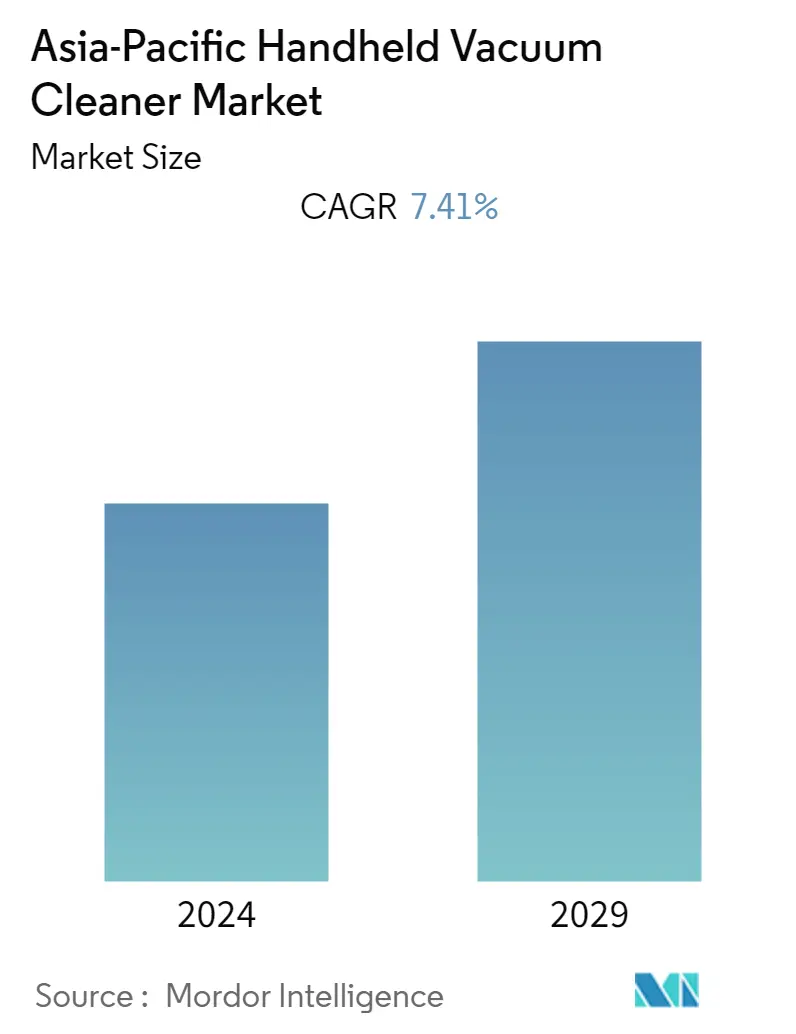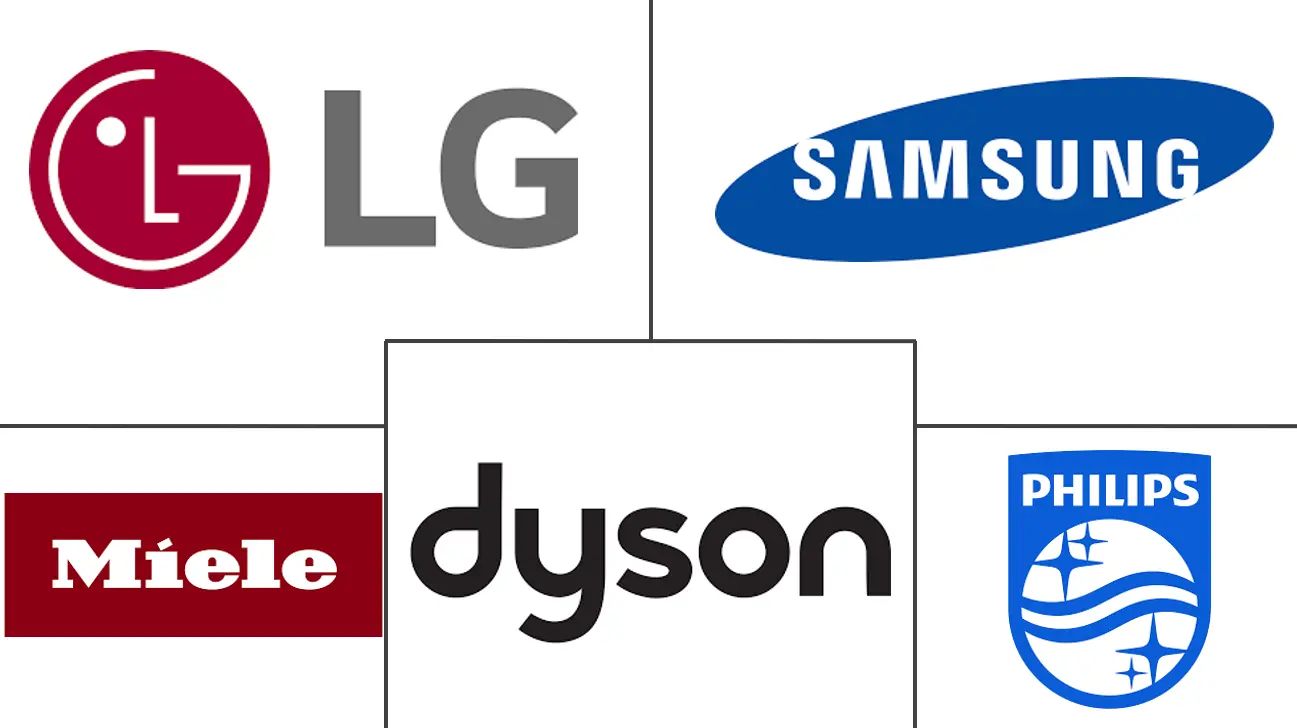Market Size of Asia-Pacific Handheld Vacuum Cleaner Industry

| Study Period | 2020 - 2029 |
| Base Year For Estimation | 2023 |
| Forecast Data Period | 2024 - 2029 |
| Historical Data Period | 2020 - 2022 |
| CAGR | 7.41 % |
| Market Concentration | Medium |
Major Players
*Disclaimer: Major Players sorted in no particular order |
Asia-Pacific Handheld Vacuum Cleaner Market Analysis
The Asia-Pacific handheld vacuum cleaner market has generated gross revenue of USD 14.45 billion in the current year and is poised to register a CAGR of 7.41 % for the forecast period. The major segment of demand for handheld vacuum cleaners is the household segment, with China, India, Japan, and Indonesia among the existing countries in the Asia-Pacific with the largest number of households. As Asia-Pacific exists as the fastest-growing economy, hospitals and commercial business office space in the region are expanding continuously in the region, raising demand for a hygienic and clean environment for which handheld vacuum cleaner is an affordable and efficient option.
With the advent of COVID-19, most people were restricted in their homes, and the pressure of managing office jobs and household chores with increasing health concerns led people to adopt vacuum cleaners in their households. In addition to this, during the same period with global supply chain disruptions, there occurred a supply shock in the market, which resulted in higher prices of handheld vacuum cleaners because of a decrease in their supply.
Post-COVID-19 demand for the smart cleaning market in the Asia-Pacific is observing steady growth with higher health and safety standards adoptions in households and businesses. Australia, China, Hongkong, and India had emerged as countries with the largest average monthly salary in the region, resulting in increased household expenditure creating a positive externality for handheld vacuum cleaner sales. The launch of cordless handheld vacuum cleaners is increasing the portability and accessibility of the devices with their availability in different sizes, making them able to clean difficult spaces.
Asia-Pacific Handheld Vacuum Cleaner Industry Segmentation
Handheld vacuum cleaners exist as cleaning devices featuring a grab-and-go design, providing faster and more effective cleaning without much lifting. They feature compact and powerful motors for complete cleaning and are small enough to clean difficult-to-reach spaces. Asia Pacific handheld Vacuum Cleaners Market is segmented by Type (Corded, Cordless), By Application (Residential, Commercial), By Distribution Channel (Online and Offline), By Country (China, India, Japan, South Korea, and Rest of Asia Pacific). The report offers Market size and forecasts for the Asia-Pacific handheld vacuum cleaner market in value (USD) for all the above segments.
| By Type | |
| Corded | |
| Cordless |
| By Application | |
| Residential | |
| Commercial |
| By Distribution Channel | |
| Online | |
| Offline |
| By Country | |
| China | |
| India | |
| Japan | |
| South Korea | |
| Rest of Asia Pacific |
Asia-Pacific Handheld Vacuum Cleaner Market Size Summary
The Asia-Pacific handheld vacuum cleaner market is experiencing robust growth, driven by increasing demand in the household segment, particularly in countries like China, India, Japan, and Indonesia. As the region continues to expand economically, the need for hygienic environments in hospitals and commercial spaces is propelling the adoption of handheld vacuum cleaners. The COVID-19 pandemic further accelerated this trend, as more people worked from home and sought efficient cleaning solutions amid health concerns. Despite supply chain disruptions leading to higher prices, the market is witnessing a steady recovery with a focus on smart cleaning technologies. The introduction of cordless and portable vacuum cleaners is enhancing their appeal, making them more accessible for cleaning challenging spaces.
The Asia-Pacific region is poised to lead global consumption growth, with local and regional brands capturing significant market share in consumer electronics. The rising per capita income and willingness to invest in premium household appliances are boosting sales of handheld vacuum cleaners with advanced features like smart sensors and cordless functionality. Urban areas, with their higher living standards and income levels, are driving demand, creating opportunities for manufacturers. The market is fragmented, with major players like LG Electronics, Samsung, Dyson, Philips, and Miele actively launching new products to cater to the growing consumer base. As megacities expand, the demand for technologically advanced cleaning appliances is expected to rise, further fueling market growth in the region.
Asia-Pacific Handheld Vacuum Cleaner Market Size - Table of Contents
-
1. MARKET DYNAMICS AND INSIGHTS
-
1.1 Market Overview
-
1.2 Market Drivers
-
1.2.1 Rise in demand of handheld cordless small-sized vacuum cleaner
-
1.2.2 Rising level of Income and household expenditure
-
-
1.3 Market Restraints
-
1.3.1 Rise in price of Household appliances post covid
-
1.3.2 Supply chain disruptions with geopolitical issues affecting the supply.
-
-
1.4 Market Opportunities
-
1.4.1 Technology innovation with sensors and durable battery backup increasing demand
-
1.4.2 Rise in adoption of handheld vacuum in office and commercial spaces.
-
-
1.5 Industry Attractiveness - Porter's Five Forces Analysis
-
1.5.1 Bargaining Power of Buyers
-
1.5.2 Bargaining Power of Suppliers
-
1.5.3 Threat of New Entrants
-
1.5.4 Threat of Substitutes
-
1.5.5 Intensity of Competitive Rivalry
-
-
1.6 Technological Innovations in Asia-Pacific Handheld Vaccum Cleaners
-
1.7 Impact of COVID-19 on the Market
-
-
2. MARKET SEGMENTATION
-
2.1 By Type
-
2.1.1 Corded
-
2.1.2 Cordless
-
-
2.2 By Application
-
2.2.1 Residential
-
2.2.2 Commercial
-
-
2.3 By Distribution Channel
-
2.3.1 Online
-
2.3.2 Offline
-
-
2.4 By Country
-
2.4.1 China
-
2.4.2 India
-
2.4.3 Japan
-
2.4.4 South Korea
-
2.4.5 Rest of Asia Pacific
-
-
Asia-Pacific Handheld Vacuum Cleaner Market Size FAQs
What is the current undefined size?
The undefined is projected to register a CAGR of 7.41% during the forecast period (2025-2030)
Who are the key players in undefined?
LG Electronics, Samsung, Dyson, Philips and Miele are the major companies operating in the undefined.

